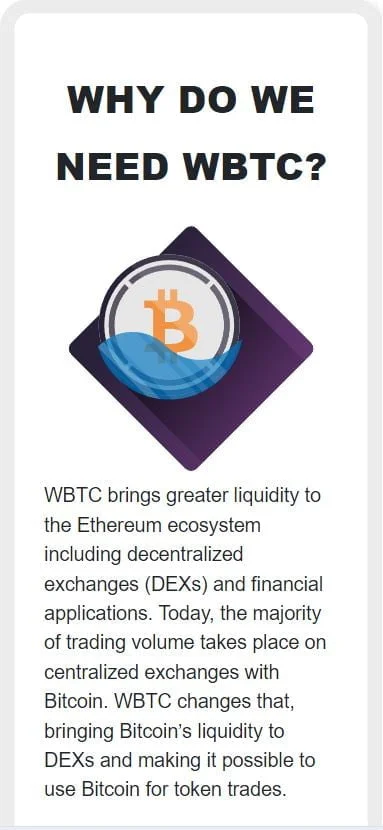Overview Wrapped Bitcoin (WBTC)
Wrapped Bitcoin (WBTC) is a tokenized version of Bitcoin (BTC) on the Ethereum blockchain, designed to bring the liquidity and value of Bitcoin to the decentralized finance (DeFi) ecosystem. It allows Bitcoin holders to participate in Ethereum-based DeFi applications without needing to convert their BTC to ETH. Each WBTC token is backed 1:1 by Bitcoin, meaning for every WBTC in circulation, there is an equivalent amount of BTC held in a custodial account. This provides a bridge between Bitcoin and the Ethereum ecosystem, facilitating greater utility and liquidity for BTC holders.

Key Features of WBTC
- ERC-20 Token:
- WBTC is an ERC-20 token, meaning it follows Ethereum’s widely-used token standard, which makes it fully compatible with Ethereum wallets, decentralized exchanges (DEXs), and other Ethereum-based platforms.
- As an ERC-20 token, WBTC can be easily integrated into the DeFi ecosystem, allowing users to participate in activities like lending, borrowing, yield farming, and trading directly with their Bitcoin holdings.
- 1:1 Backing:
- Each unit of WBTC is backed by an equivalent amount of Bitcoin held by a trusted custodian. The primary custodians include BitGo, Coinbase Custody, and Gemini Custody, which ensure that Bitcoin is securely held and that the WBTC issued on Ethereum is fully collateralized.
- This 1:1 backing means that users can always redeem WBTC for the equivalent amount of BTC, providing transparency and assurance.
- Enabling DeFi Participation:
- WBTC opens the door for Bitcoin holders to participate in Ethereum’s DeFi ecosystem, which is one of the largest and fastest-growing sectors in the blockchain space. By converting BTC into WBTC, users can access decentralized lending and borrowing platforms (such as Aave and Compound), decentralized exchanges (such as Uniswap and SushiSwap), and yield farming protocols.
- It enables users to earn interest, fees, and rewards on their Bitcoin holdings while still retaining exposure to Bitcoin’s price movements.
- Token Minting and Redemption:
- To mint WBTC, users must deposit BTC into the custody of a trusted custodian. After the deposit, an equivalent amount of WBTC is minted on the Ethereum blockchain.
- Redemption allows users to exchange WBTC back to BTC by going through the same custodianship process. This process ensures that there is always an adequate amount of Bitcoin backing the WBTC tokens in circulation.
- Decentralized Governance:
- WBTC is governed by the WBTC DAO (Decentralized Autonomous Organization), which includes a variety of stakeholders, including custodians, merchants, and users. The DAO oversees important governance decisions, such as updates to the token’s issuance process or custodial practices, ensuring that the protocol evolves with the needs of its users and the DeFi ecosystem.
History and Development of WBTC
- Launched in January 2019, WBTC was developed as a collaborative effort by BitGo, Kyber Network, and Ren Protocol. The goal was to enhance Bitcoin liquidity within the Ethereum ecosystem, making Bitcoin more accessible to decentralized applications and DeFi protocols.
- The initial creation of WBTC allowed Bitcoin holders to access the growing Ethereum ecosystem without the need to sell or convert their BTC. It also introduced Bitcoin’s liquidity into the Ethereum ecosystem, supporting the growth of decentralized exchanges and lending platforms.
- Over time, additional custodians and merchants have been added to the WBTC network, and more Ethereum-based DeFi protocols have integrated WBTC as an accepted asset. This has driven the growth of BTC-ETH liquidity pools, decentralized trading, and more sophisticated financial services built on top of Ethereum.
Strengths of WBTC
- Increased Bitcoin Liquidity in DeFi:
- WBTC enhances Bitcoin’s liquidity in DeFi, allowing Bitcoin holders to participate in Ethereum’s decentralized finance ecosystem. This opens up new opportunities for lending, borrowing, and yield generation without having to convert Bitcoin into Ethereum or any other token.
- Interoperability with DeFi:
- As an ERC-20 token, WBTC is fully compatible with Ethereum’s DeFi infrastructure, meaning it can be used across a broad range of DeFi protocols and applications. This compatibility allows for seamless integration with popular Ethereum-based platforms such as Uniswap, SushiSwap, Aave, and Compound.
- Security and Custodianship:
- WBTC is backed by reputable custodians like BitGo and Coinbase Custody, ensuring that Bitcoin is stored securely and that the WBTC issuance process is transparent and reliable. These custodians are required to undergo regular audits to maintain the integrity and transparency of the WBTC ecosystem.
- Retains Bitcoin Exposure:
- By converting BTC to WBTC, holders retain exposure to Bitcoin’s price action while gaining the ability to earn passive income through DeFi applications, like lending or staking. This makes WBTC an attractive option for those looking to leverage their Bitcoin holdings without selling them.
- Decentralized Governance:
- WBTC is governed by a DAO, allowing stakeholders to participate in the decision-making process, ensuring that the protocol evolves in a decentralized and community-driven manner.
Weaknesses and Risks of WBTC
- Dependency on Custodians:
- WBTC’s issuance and redemption process rely on third-party custodians, such as BitGo and Coinbase Custody. This introduces a level of centralization and counterparty risk, as the process depends on the integrity and security of these custodians.
- If a custodian were to face security issues, such as a hack or failure, it could lead to the loss or freezing of WBTC or the Bitcoin held as collateral.
- Legal and Regulatory Challenges:
- As a derivative product, WBTC might face legal and regulatory scrutiny in some jurisdictions. Regulators may view tokenized assets like WBTC differently from traditional cryptocurrencies or may impose additional regulatory requirements. This could create risks for users or institutions involved in its use.
- Since WBTC is created and managed by a consortium of custodians, questions regarding legal ownership, custody, and asset transparency may arise.
- Systemic Risks:
- The reliance on centralized custodians introduces systemic risk in the event that the custodian goes bankrupt, faces a regulatory challenge, or experiences a security breach.
- There is also a risk of the custodians failing to properly manage the BTC reserves, which could lead to issues with WBTC’s 1:1 backing.
- Custodian Fees:
- Custodians charge fees for minting and redeeming WBTC. These fees could reduce the economic efficiency of using WBTC in smaller transactions, as the costs may become prohibitive for some users.
- Lack of Bitcoin’s Full Security:
- While WBTC provides a way to bring Bitcoin to Ethereum, the security of Bitcoin itself is not replicated on Ethereum. Users need to trust the Ethereum network and custodians, and any vulnerabilities in Ethereum smart contracts or consensus mechanisms could affect the safety of WBTC.
Use Cases of WBTC
- Accessing DeFi:
- Lending and Borrowing: Bitcoin holders can use WBTC to participate in lending protocols like Aave or Compound, earning interest on their holdings. They can also use WBTC as collateral to borrow other assets.
- Decentralized Trading: WBTC can be used for trading on decentralized exchanges (DEXs) like Uniswap or SushiSwap, allowing users to trade Bitcoin for other tokens on the Ethereum network.
- Yield Farming: By adding WBTC to liquidity pools on platforms like Uniswap or Balancer, users can earn a share of transaction fees and yield farming rewards.
- Bitcoin Hedging:
- Users can hedge their exposure to Bitcoin by participating in DeFi strategies without selling their BTC. WBTC allows them to maintain exposure to Bitcoin’s price while utilizing DeFi tools to generate additional returns.
- Cross-Chain Bridges:
- WBTC can also serve as a bridge between Bitcoin and other blockchain ecosystems, like Binance Smart Chain or Solana, where users may want to transfer or utilize their Bitcoin holdings in different ecosystems.
Wrapped Bitcoin (WBTC) is a key innovation in the DeFi space, bringing Bitcoin’s liquidity to Ethereum-based decentralized finance platforms. By tokenizing Bitcoin and making it an ERC-20 token, WBTC allows Bitcoin holders to earn yields, borrow assets, trade, and participate in the broader Ethereum ecosystem without needing to sell their Bitcoin.
While WBTC provides clear advantages in terms of liquidity and accessibility to DeFi, it comes with certain risks, particularly around its dependency on centralized custodians and potential regulatory concerns. As always, users should be aware of these risks and ensure they understand the implications before using WBTC in DeFi applications.























Harran –
👍
Brian’s niche –
Good !